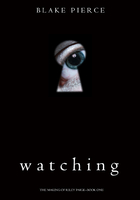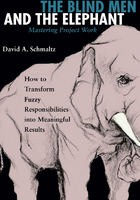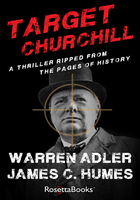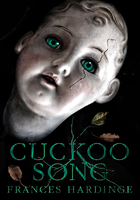'HE IS THE NAPOLEON OF CRIME'
THE 1880s WAS THE DECADE in which Holmes investigated the villainies of Dr Grimesby Roylott and his stepdaughter's fear of the 'speckled band' that had killed her sister. It was also the decade in which he and Watson encountered the five orange pips that marked the murderous persecution of the Openshaw family, pursued Jonathan Small and his Andamanese companion down the Thames in The Sign of Four and sought to explain the strange circumstances in which the young engineer Victor Hatherley lost his thumb in a vicious attack. All these cases, and others, are meticulously documented by Watson, yet the doctor records only some two dozen cases in total from the decade. It is a curious fact that Watson chooses to document very few cases from his early association with Holmes. After the initial adventure described in A Study in Scarlet, there are no further cases in Watson's archives for two years. 'The Adventure of the Speckled Band', which occurred in 1883, is followed by another hiatus in the annals that is only ended by 'The Adventure of the Beryl Coronet' events in which date from 1886. 'The Adventure of the Resident Patient' and 'The Adventure of the Rcigate Squire' both record tales from 1887 and they are followed by a flurry of cases from 1888 and 1889. These two years alone contain nearly a third of the total number of adventures that Watson decided to publish, from the journey to Dartmoor to investigate the disappearance of the racehorse Silver Blaze to the unveiling of Neville St Clair's bizarre profession in 'The Man with the Twisted Lip'. If we assume that each of these cases took, on average, a week of Holmes's time, less than six months of the detective's activities in some ten years are accounted for. The truth is that the reader searches Watson's narratives in vain for more than a passing hint of the three subjects that took up most of Holmes's energies in the 1880s: Ireland, the political and sexual scandals of the ruling classes and the Whitechapel murders. In 'The Adventure of the Bruce-Partington Plans', Watson writes of 'that secret history of a nation which is often so much more intimate and interesting than its public chronicles'. Watson was largely silent about that secret history even when he was implicated in it himself. His silence for much of the decade becomes less surprising when we realize just how far his friend was drawn into the British government's continuing battle against Irish nationalism in all its forms, from the parliamentary campaigns of Parnell and his party to the terrorism of the Fenians and their American supporters.
The Irish question was a running sore on the body politic of Britain throughout the second half of the nineteenth century. Ultimately, it was a question that could not be answered. The Irish, or large numbers of them, wanted independence for their country. The British, or large numbers of those with the power to grant it, did not wish to oblige. There was no compromise to be reached and, until the announcement of Gladstone's conversion to the idea of Irish Home Rule in late 1885, no hope of a settlement. Advocates of Irish independence came in a thousand different hues but there was one broad division within their ranks. On one side of this divide stood those who believed in 'moral force' and peaceful parliamentary means to gain their goal; on the other side were those who thought that only 'physical force' and violent uprising would achieve the desired end. In the course of the 1880s both varieties of Irish nationalist were to take up much of Sherlock Holmes's energies.
The history of Ireland in the nineteenth century was littered with doomed but heroic rebellions against British rule; it was also scarred by the terrible tragedy of the 1840s potato famine. In the years in which Sherlock Holmes had been a teenager at Hutton Hall and his brother had been swapping mathematical puzzles with Lewis Carroll in Oxford, wild plots proliferated on both sides of the Atlantic. The Irish Republican Brotherhood – known as the Fenians after the legendary 'Na Fianna', bodyguards to the old High King of Ireland – was founded in 1858. In 1866 a madcap Fenian scheme to invade Canada with an army of Irish-American patriots, many of them veterans of the American Civil War, ended in fiasco. The following year violence crossed the Atlantic and, in Manchester, a police van carrying Fenian prisoners was ambushed by thirty armed men. One of the police guards was shot dead and the prisoners released. The worst of the Fenian atrocities that year took place in Clerkenwell when an attempt to spring two activists from the prison there resulted in an explosion that killed twelve people and injured dozens more. Another foray across the Canadian border in 1870 was even more disastrous than the first.
Throughout the 1870s physical-force Irish Republicans were largely engaged in licking their wounds and squabbling among themselves, although elaborate and unlikely plans were cooked up to foment trouble throughout the British Empire from South Africa to the frontiers of India. Most sounded more like the plots of boys' adventure stories than serious attempts to undermine British authority. The advocates of peaceful progress towards independence were meanwhile gaining strength. In 1875 the man who was to become the leader of parliamentary Irish nationalism, Charles Stewart Parnell, was elected MP for Meath. In 1879 the Irish National Land League was founded with the aim of forcing reform on absentee landlords in Ireland and, ultimately, transferring Irish land into Irish hands.
It was at this point that Mycroft Holmes entered the Irish arena. One of Mycroft's greatest advocates was Arthur Balfour, a young man with powerful family connections. A year younger than Mycroft, Balfour was the nephew of Robert Gascoyne Cecil, 3rd Marquess of Salisbury (the phrase 'Bob's your uncle' is said to derive from the cosy relationship between them), and, when his uncle was appointed Foreign Secretary in 1878, he became his private secretary. In this role he met Mycroft and was immediately impressed, as so many were, by the extraordinary mind that lurked behind the plump and indolent fa?ade that Holmes's elder brother presented to the world. It was Balfour, with the power of his uncle behind him, who first suggested that Mycroft should turn his thoughts across the Irish Sea, originally with the intention of gaining further information about the Irish National Land League and Parnell's involvement with it. Although the Conservative government was ousted at the 1880 general election, Mycroft, once installed anywhere, usually proved immune to changes of government. Wisely, the incoming Gladstone government decided to allow him a free brief to follow events in Ireland.
By the early 1880s wild rumours about Irish plots were gathering pace in the corridors of Whitehall, as well as in the columns of the more excitable newspapers and periodicals. There were reports from America that hundreds of revolutionists there had formed a secret society, the Knights of Hassan-ben-Sabbah-el-Homari, named after the original founder of the hashish-smoking assassins of eleventh-century Persia. Dedicated to spreading terror through murder, agents of the Knights were preparing to sail the Atlantic and begin their campaigns in Britain. The royal family was at terrible risk. 'Dynamite will be deposited in the coffins in Windsor,' one anonymous correspondent from Chicago reported to the British consulate in that city, 'and blown up with an electric battery when the Queen is staying there.' Ludicrous as these stories might have been, they could not be entirely ignored. Explosions earlier in the year, the work of agents sent from the United States, had shown that there were Irishmen sufficiently committed to their cause to plant bombs in mainland Britain. The assassination of Tsar Alexander II in March 1881 made it clear that not even monarchs – perhaps especially not monarchs – were safe from the danger. Mycroft was more concerned with the escalating troubles in the Irish countryside, sponsored by the Land League, than he was by what were most likely the fantastical products of lengthy drinking sessions in New York bars. Nonetheless he commissioned his brother to travel to Dublin on a largely unofficial investigation into links between firebrands in America and the wilder nationalists in Ireland.
Holmes was not nearly as infallible as Watson's admiring accounts usually suggest and the detective was himself the first to admit this. 'I made a blunder, my dear Watson,' he acknowledges during his 1888 investigation into the disappearance of the racehorse Silver Blaze, 'which is, I am afraid, a more common occurrence than anyone would think who only knew me through your memoirs.' Six years earlier, in Dublin, Holmes had made a more serious blunder and the result was tragedy. Throughout the earlier part of 1882 he spent long periods in the Irish capital, slowly working his way through agents' reports on nationalist activity as they reached the authorities at Dublin Castle and painstakingly building up his own network of contacts. Towards the end of April, word reached him that some kind of dramatic attack on the government in Ireland was in the offing. For reasons that are no longer clear, Holmes came to believe that the most likely target for such an attack was the armoury at Dublin Castle. Throughout the last week of April and the first few days of May, he bombarded Dublin Castle with peremptory instructions, couched in his usual, terse style of address, about defence of the armoury. Many of the senior civil servants in Dublin had, by this time, come to resent what they saw as the interference of this emissary from London, with his ill-defined powers and abrupt manner, but they had also come to appreciate that, somehow, he had the backing of the highest authorities in Whitehall. Most of Holmes's suggestions were acted upon and he felt able to relax, confident that he had thwarted the plans of the potential rebels.
On the night of 6 May he was attending a performance by the Carl Rosa Opera Company of Maritana, a then well-known opera by the Irish composer William Vincent Wallace.[10] We do not know what Holmes, an admirer of Wagner and German music, made of the saccharine melodies and overblown plot of Maritana, a tale of a street singer and her complicated amour with the King of Spain, but the news brought to him by an emissary from Dublin Castle must have sent all thoughts of music flying from his mind. There had been no assault on the armoury. The extreme nationalists had turned to assassination. Earlier that evening, as they walked through Phoenix Park in the city, the new Chief Secretary of Ireland, Lord Frederick Cavendish, and one of his leading civil servants, Thomas Burke, had been confronted by four men wielding surgical knives. Cavendish and Burke were stabbed and slashed at repeatedly. Both died from their wounds. Later reports sent to a Dublin newspaper claimed that a group calling itself the 'Irish Invincibles' was responsible. Although Holmes had been in Dublin, and had had early hints that some major terrorist assault was planned, he had proved powerless to prevent the murders.
In the months following the killings in Phoenix Park, Holmes flitted back and forth between London and Dublin. The official investigation into the assassination, led by Dublin superintendent John Mallon, seemed unable to identify the 'Invincibles' or to track them down. Dozens of men were arrested, interrogated and then released. Mallon appeared no closer to bringing the murderers to justice. Eventually, in January 1883, thanks to the evidence of an informer, thirteen men were brought to trial. Five were sentenced to hang. However, nobody, least of all Holmes and his brother, believed that the true masterminds behind the Phoenix Park killings had been uncovered. Mycroft insisted that Sherlock's investigations in Ireland should continue. Indeed, it was in the second half of 1882, as he struggled to make sense of the labyrinthine politics of Irish nationalism, that Holmes first heard the name Moriarty.
It is often claimed that Watson simply invented Moriarty or that he used the name 'Moriarty' to disguise the identity of the real 'Napoleon of crime', Adam Worth, described by one commentator as 'the outstanding criminal of the Victorian age'. Worth, whose exploits included the daring theft of Gainsborough's portrait of Georgiana, Duchess of Devonshire, from the London art dealers Agnew's in 1876, followed by a succession of inventive scams and frauds, was certainly a remarkable criminal. The system he developed – in which he used a chain of intermediaries as a buffer between himself and the actual commission of the crime, so that those most likely to be caught by the police remained ignorant of the true organizers – certainly sounds very like that employed by Moriarty in his half-criminal, half-political endeavours. However, Worth was not Moriarty. Nor did Watson's portrayal of Moriarty owe much to stories of James Townsend Saward, the barrister and forger known as Jim the Penman who, in the 1850s, used a string of accomplices to cash bad cheques in London banks and was transported to Australia in 1857. Moriarty was no fictional creation nor was he one of the names Watson used to hide another's identity. Moriarty was very much a real person and he was to haunt Holmes for most of the 1880s.
Watson, reporting Holmes's own words, tells us much about Moriarty.
He is a man of good birth and excellent education, endowed by Nature with a phenomenal mathematical faculty. At the age of twenty-one he wrote a treatise upon the Binomial Theorem, which has had a European vogue. On the strength of it, he won the Mathematical Chair at one of our smaller universities, and had, to all appearance, a most brilliant career before him. But the man had hereditary tendencies of the most diabolical kind. A criminal strain ran in his blood, which, instead of being modified, was increased and rendered infinitely more dangerous by his extraordinary mental powers. Dark rumours gathered round him in the university town, and eventually he was compelled to resign his Chair and to come down to London, where he set up as an army coach.
This is a neat thumbnail sketch of his career yet Watson fails to reveal the single most important fact about the criminal mastermind. Moriarty was Irish.[11]
The name derives from the Gaelic O'Muircheartaigh and, throughout the Middle Ages, the clan was a major power in the west of Ireland. The Moriartys could even claim a twelfth-century King of West Munster among their ancestors. Most Moriartys in the mid-nineteenth century came from County Kerry but James Nolan Moriarty was born in 1849 in Greystones, a small town on the coastal road between Dublin and Wicklow, the son of an impoverished Catholic land agent in his mid-forties and his much younger wife. (Why Holmes believed that there was a 'criminal strain' running in Moriarty's blood is unclear. James Moriarty Senior was an upstanding, if undistinguished, member of his community and there is no indication that his forebears were anything else.)
What little evidence we have for Moriarty's childhood (two surviving letters written by his mother, a brief reference in a Dublin newspaper of 1858 to a calculating prodigy) reveals that his remarkable mathematical skills were present from an early age. Like Holmes, Moriarty was a difficult child and he was educated largely at home. It is not known who encouraged and fostered his mathematical talent but, by the age of seventeen, he had already published his first academic papers and sought admission to a university. As a Catholic, Moriarty was unable to enter Trinity College, Dublin, which was an exclusively Protestant establishment. The alternative was the newly founded University College, Dublin, and Moriarty became an undergraduate there in the autumn of 1867. Already his abilities were in a different league to those of his teachers and he seems to have devoted most of his time at UCD to lengthy correspondence with European professors who were better able to follow him into the abstruse mathematical territory he was now entering.
In 1871, having graduated from UCD with the highest first of his year, he published the results of his work over the previous four years or so. Although it appeared under the imprint of a small Dublin publisher, A Treatise on the Binomial Theorem made Moriarty's reputation. Carefully sending presentation copies to the mathematicians he had cultivated on the Continent (the treatise was actually dedicated to Carl Gottfried Neumann, a professor at the University of Leipzig), Moriarty nurtured the fame he had gathered and as a result several universities approached him with requests that he join their teaching staff. He had been hoping for a position at either Oxford or Cambridge but, again, his Catholicism stood in the way. Durham, however, although equally committed to the Church of England, seemed prepared to turn a blind eye to his now lapsed religious affiliations.
In the autumn of 1872, aged only twenty-three and still basking in the glory that his treatise had brought him, Moriarty crossed the Irish Sea for the first time and took up his professorship at Durham. The description of Moriarty that Holmes later provides, coloured as it is by the detective's own prejudice against the man, gives a sense of the markedly distinctive figure who was about to become a familiar sight in the streets of Durham. 'He is extremely tall and thin, his forehead domes out in a white curve, and his two eyes are deeply sunken in this head. He is clean-shaven, pale, and ascetic-looking, retaining something of the professor in his features. His shoulders are rounded from much study, and his face protrudes forward, and is forever slowly oscillating from side to side in a curiously reptilian fashion.'
Moriarty remained in the North of England for six years, during which time his mathematical reputation only grew but he was to leave Durham, as Holmes notes, under a cloud. It is unclear what the 'dark rumours' were that gathered there around Moriarty. His name has been carefully excluded from the archives of the university so we must assume that they were very serious indeed. The likelihood is that, at the very least, word reached the authorities of his growing association with the more extreme elements in the Irish nationalist movement. At University College, Dublin, Moriarty had joined the Clan na Gael and, despite moving to England, he had almost certainly maintained contact with its representatives both in Ireland and elsewhere.
Whatever his crime, Moriarty was pressured into resigning his professorship and he moved to London in 1878. He was twenty-nine and at the peak of his mathematical brilliance, yet the only job he could find was as an army coach. One can only speculate whether Moriarty was bitter at being reduced to this but in all likelihood his resentment must have been fierce. Here was one of the great mathematical minds of Europe, a man who had corresponded on equal terms with the likes of Georg Cantor and Carl Neumann, forced to cram the basics of algebra and geometry into the plodding brains of would-be soldiers. Exiled from the intellectual world, he plunged even deeper into the plots and counterplots of those determined to win Irish independence by any means, legal or illegal. Ironically, it was his mathematical genius that made him useful to them. Moriarty became a creator of ciphers and a breaker of codes.
The codes that the Fenians had been using before Moriarty entered their midst had been childishly easy to unravel. Some messages were sent in which the only attempt at secrecy was a halfhearted transposition of one letter for another according to its place in the alphabet. 'B' would substitute for 'A', 'C' for 'B', 'D' for 'C' and so on. Unsurprisingly, even the most unsophisticated police agent was usually able to read supposedly secret communications between the nationalists. Under Moriarty's guidance, and with his exceptional mathematical gifts, the codes became fiendishly complex.
Holmes was an expert on codes. As he said to Watson in 'The Adventure of the Dancing Men', 'I am fairly familiar with all forms of secret writing, and am myself the author of a trifling monograph upon the subject, in which I analyse one hundred and sixty separate ciphers.' His knowledge was practical as well as theoretical. 'There are many ciphers which I would read as easily as I do the apocrypha of the agony column,' he boasted to Watson; 'such crude devices amuse the intelligence without fatiguing it.' In the months since the outrage at Phoenix Park, Holmes had been working on coded communications between the nationalists that the police had intercepted. Soon he began to realize that the ciphers he was now seeing were the work of a mind of a different calibre to those that had produced the earlier codes.
In the wake of the Phoenix Park murders, the rumours of plots and planned assassinations that reached the Foreign Office and soon found their way to Mycroft's desk began once more to grow in number. Princess Louise, one of Victoria's daughters, was to visit Canada and there she would be abducted by a gang of committed Irish nationalists travelling up from New York. Two Sicilians, seasoned experts in the art of political murder, had been hired by a wealthy Irishman to journey to London and do away with the Prince of Wales. Mycroft, alternately irritated and darkly amused by these largely preposterous stories, was being urged to take action, which of course was not his forte but his brother's. Annoyed though he was by what he continued to believe was Sherlock's negligence in Dublin, he had little hesitation in employing him again. It was time for Holmes to combine his work on the ciphers with more active investigations.
It was a minefield of conflicting loyalties, double agents and secret societies into which Holmes now stepped. Irish nationalism was itself hopelessly divided, not only between those who advocated a peaceful parliamentary pursuit of independence and those who wanted to use physical force to end British rule. The men of violence, in the wake of the disastrous failings of the 1860s, had splintered into numerous small groups, each certain that it, and it alone, was the true torchbearer for the nationalist cause. The Clan na Gael, founded in 1867, squabbled with those loyal to Jeremiah O'Donovan Rossa, a former Fenian prisoner who had been released into American exile in 1871. Irishmen at home in Dublin and Cork resented the interference of the often well-funded activities of those who had emigrated to the United States. One such was General Millen, a Tyrone-born adventurer who had fought with Benito Juarez's armies in Mexico and who had been involved in a dozen plots against British power in Ireland and elsewhere in the 1860s and 1870s. He and men like him were quite prepared to change sides and act as informers for the very government that they were still working to subvert.
Those responsible for protecting Britain and the Empire from Irish terrorism were equally divided. Home Office civil servants bickered with ministers. Ministers failed to agree with the police. The police brooded over the interference of politicians and special agents. In the midst of this the Holmes brothers wove their own web of intrigue. The formation in March 1883 of a new 'Irish Bureau' in the Metropolitan Police, headed by the legendary and flamboyant Chief Inspector Adolphus 'Dolly' Williamson, should have solved many of the problems. Instead, it made them worse. At the heart of the chaos was a man who was soon to become almost as much trouble for the Holmes brothers as Moriarty.
Edward Jenkinson was an ex-Harrovian (he had been at the school a decade before Myroft arrived). In the wake of the Phoenix Park murders this civil servant returned from India and in his new appointment quickly established his own network of spies and double agents who answered to him personally rather than to any government or police authority.[12] Jenkinson was soon filling much the same role as had Holmes in late 1881 and early 1882, working as a freelance agent with mysterious powers granted by senior figures in Whitehall who could, and would, quite happily wash their hands of him if it became expedient to do so. Both Holmes brothers resented Jenkinson's intrusion into the arena but there was little they could do. He had the backing of the highest authorities.
Whatever the British government did, whatever plots and counterplots were devised by the likes of Jenkinson and Mycroft Holmes, they all seemed to have little effect on the men of violence. Each year in the 1880s saw an increase in Fenian activity. In the spring of 1883, a bomb exploded in the heart of Whitehall. No one was hurt but the bombers had made an impressive display of their ability to reach right into the very heart of the British establishment. In the autumn of the same year, there were two explosions on underground trains, one on the Metropolitan Line at Paddington, the other on the District Line at Westminster Bridge. Dozens of people were injured, some very seriously. The Holmes brothers may have been engaged in a bitter battle for behind-the-scenes influence with Edward Jenkinson but they would have agreed with him when he wrote in exasperation: 'I gave Harcourt [the Home Secretary] warning in the spring that they meant to attack the Underground railway.' Although Mycroft and Sherlock had for some time given clear indications of the threat Moriarty and his colleagues represented, they had met chiefly with bureaucratic frustration.
The circumstantial evidence against the ex-professor remained flimsy. Despite the dubious circumstances in which he had left Durham, Moriarty was still able to maintain a veneer of respectability. As Holmes warned Watson, 'In calling Moriarty a criminal you are uttering libel in the eyes of the law … so aloof is he from general suspicion, so immune from criticism, so admirable in his management and self-effacement, that for those very words that you have uttered he could hale you to a court and emerge with your year's pension as a solatium for his wounded character.'
For the authorities the most embarrassing of all the bomb outrages took place on 30 May 1884. The bombers struck, literally, in the police's own backyard. Shortly after nine o'clock at night PC 417 Clark, who had the unenviable job of guarding the public urinal at the rear of Scotland Yard, was blown thirty feet through the air by the explosion of a massive device planted there. The Rising Sun, a pub across the street that was filled with off-duty policemen supping their pints, became a whirlwind of flying glass and splintered wood. Many were injured. Holmes, working night and day on coded communications between the Fenians, most of them the product of Moriarty's fertile mathematical mind, had only succeeded in a partial unravelling of the plot. He was unable to predict the bomb in the Rising Sun but, thanks to his warning, another bomb that had been set to explode at the base of Nelson's column was found before it went off.
The campaign, however, was far from over. The following year, 1885, saw bombs successfully detonated at the Tower of London, London Bridge and the Palace of Westminster. The 'infernal machine' in Parliament was found on 24 January in a black bag by a Mr Green, his wife and sister-in-law, tourists who were wandering, unshepherded, around the chapel of St Mary Undercroft, and reported their discovery to the policeman on duty, a PC Cole. By the time Cole reached the device it was smouldering but, showing courage beyond the call of duty, he picked it up and ran up the stairs to Westminster Hall, preceded by Mr Green yelling, 'Dynamite!' Another police officer, PC Cox, now joined his colleague and, as the two debated what to do, the bomb became too hot for Cole to hold. He dropped it to the ground whereupon it exploded, blowing both the policemen off their feet and leaving the two ladies in Mr Green's party 'bereft of their upper garments'. As others rushed to the scene another device, which had been left in the actual chamber of the House of Commons, also went off. Parliament was in recess and no one was hurt but once again the dynamiters had demonstrated their power to reach into the heart of the government. Holmes, who had been recommending greater security at key locations such as Parliament, was furious. His transcriptions of coded letters between the bombers and their sympathizers – as well as the conclusions he had drawn from them – had been lost in the bureaucratic tangle that surrounded all attempts to deal with the Irish incendiaries.
By this time, Mycroft and Sherlock Holmes were obsessed by Moriarty. There is no question that the professor had been involved in the planning of both the Phoenix Park murders and the bombings of the mid-i88os but it is doubtful whether he was the master-mind that the Holmes brothers believed him to be. The underworld of physical-force Irish nationalism was too fragmented and too divided against itself to allow for the emergence of such a mastermind. There is a sense in which the two brothers were too logical, too committed to tracing a pattern beneath the seeming chaos for their own good. 'Perhaps, when a man has special knowledge and special powers like my own,' Holmes once remarked to Inspector Hopkins in 'The Adventure of the Abbey Grange', 'it rather encourages him to seek a complex explanation when a simpler one is at hand.' He was right in this instance. Watson noted in The Sign of Four that, 'through the over-refinement of his logic', Holmes often preferred 'a subtle and bizarre explanation when a plainer and more commonplace one lay ready to hand'. This was a case in point. The simpler truth was that the superficial disorganization of the assorted groups was only a cover for the even deeper disorganization beneath. Mycroft and Sherlock could not accept this and they used the evidence they collected against Moriarty to elevate him to a mastermind status that he did not fully deserve. When Inspector MacDonald, in The Valley of Fear, remarks, 'We think in the C. I. D. that you have a wee bit of a bee in your bonnet over this professor,' he may have been right.
Holmes, encouraged by his brother, continued to attach a disproportionate importance to Moriarty. 'He is the Napoleon of crime,' he told Watson. 'He is the organizer of half that is evil and of nearly all that is undetected in this great city. He is a genius, a philosopher, an abstract thinker. He has a brain of the first order. He sits motionless, like a spider in the centre of its web, but that web has a thousand radiations, and he knows well every quiver of each of them.' Yet even as late as 1888, Holmes had never met Moriarty. He had broken into the professor's rooms on a number of occasions and had noted that Moriarty owned a painting by Greuze, the eighteenth-century French artist who was much admired by the Victorians and whose work fetched high prices. He knew that Moriarty was able to pay his subordinate, Colonel Moran, £6,000 a year, more than the Prime Minister earned. Yet he had never come face to face with him.
As Holmes struggled, over the next two years, to find more concrete proof that Moriarty and the crime organization that he headed were linked with violent Irish nationalism, a parallel investigation was unfolding into events surrounding the Irish parliamentary leader, Charles Parnell. Throughout the 1880s rumours were circulating of Parnell's supposed involvement in all kinds of extremist outrages, from the Phoenix Park murders to the planning of dynamite attacks. The reactions of the Holmes brothers to these rumours were ambivalent. On the one hand, they were both committed to the belief that Ireland should remain under British rule and, for a long period in the 1880s, it seemed as if Parnell had a chance of achieving through constitutional means the Irish independence that they both feared. On the other, they were both convinced, from the very beginning, that the vast majority of the claims made about Parnell were untrue.
Most of the rumours about Parnell could be, and were, dismissed out of hand. The Irish leader was always scrupulous in distancing himself from any connection with terrorism. The biggest threat to his political career came in the shape of a series of letters, allegedly bearing his signature. On 11 April 1887, the sensational contents of the letters began to be unveiled in facsimile in a series of articles in The Times with the headline 'Parnellism and Crime'. The most damaging revelation was that Parnell had apparently condoned the Phoenix Park murders, writing, 'Though I regret the accident of Lord F. Cavendish's death, I cannot refuse to admit that Burke got no more than his deserts.' A parliamentary commission was set up to investigate the claims made in the articles. It was to rumble on for the next two years and would force the Holmes brothers to reassess their tactics in their Irish investigations.
Holmes was aware from very early on that the Parnell letters were forged. The man who had brought them to the attention of the British media was a disreputable Irish journalist, Richard Pigott. According to a much later memory of George Bernard Shaw, few people in Ireland had any doubts about Pigott's reliability as a journalist. 'His routine,' said Shaw, 'was to drink himself almost to death, at which point he would write a recklessly seditious article in his paper The Irishman and get six months for it. The compulsory abstinence thus enforced restored health and enabled him to begin again.' The 'expert' employed by The Times to verify Pigott's letters may have been fooled but Holmes was not. He was a keen student of handwriting, both as a means of revealing character and as a method for deducing more basic information about the writer. In 'The Adventure of the Rcigate Squire', he tells his audience, 'You may not be aware that the deduction of a man's age from his writing is one which has been brought to considerable accuracy by experts. In normal cases one can place a man in his true decade with tolerable confidence.' Unlike the man co-opted by The Times, Holmes was one of the experts he mentioned. Parnell was forty-six; Pigott, the likely forger if the letters were false, was sixty. Holmes had little difficulty in appreciating, from this one characteristic alone, that the letters could not have been written by Parnell.
After consultation with Mycroft, Holmes had decided that the vindication of Parnell, apart from fitting better with the brothers' sense of justice and fair play, was a better outcome for the British establishment. Distracted as he was by other cases, he nonetheless plunged once more into the investigation of Parnell's and Pigott's affairs. Shortly he discovered a letter written by Pigott three days before the publication of 'Parnellism and Crime' in The Times. It provided him with the hook on which to hang the forger. When Pigott appeared before the Parnell commission, the man charged with cross-examining him, Charles Russell QC, later Lord Chief Justice of England, was armed with the information Holmes had unearthed. Holmes suggested that Russell ask Pigott to write several words on a piece of paper as soon as he rose to cross-examine him. One of the words Holmes suggested was 'hesitancy'. Pigott spelled it 'hesitency', just as it had appeared in the Parnell letters. The mistake was a damning one. Pigott was, by this time, at the end of his tether. Under Russell's relentless questioning, he was made to look the rogue and liar he was. The next day, 25 February 1889, the commission was due to sit again and Pigott's crucifixion by cross-examination would continue. The forger, however, was conspicuously absent, having fled the country. He was eventually traced to Madrid but, as the English police entered his hotel intent on questioning him further, he shot himself.
Parnell, thanks in no small part to Holmes's work behind the scenes, had been vindicated. He received compensation from The Times as well as a standing ovation, led by Gladstone, when he entered the chamber of the House of Commons.













